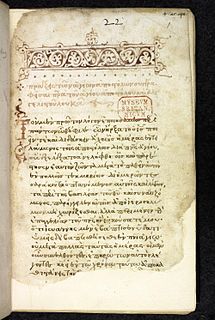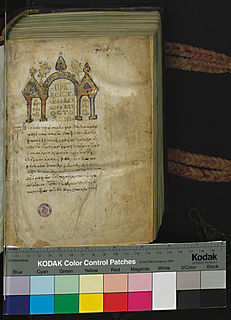Related Research Articles

Minuscule 1739, α 78, is a Greek minuscule manuscript of the New Testament, on 102 parchment leaves. It is dated paleographically to the 10th century.
Minuscule 93, α 51 (Soden), formerly known as Codex Graevii, is a Greek minuscule manuscript of the New Testament, on parchment leaves. Palaeographically it has been assigned to the 10th-century.
Minuscule 103, ΟΘ28 (Soden), is a Greek minuscule manuscript of the New Testament, on parchment leaves. Palaeographically it has been assigned to the 12th century. The manuscript has complex contents.
Minuscule 250, O 10 (Soden), is a Greek minuscule manuscript of the New Testament, on parchment. Paleographically it has been assigned to the 11th century.
Minuscule 254, ΟΘ42 (Soden), is a Greek minuscule manuscript of the New Testament, on paper. Palaeographically it had been assigned to the 11th century. Formerly it was labelled by 251a, 301p, 122r. Scrivener labelled it by 201a, 396p, 86r. It has marginalia.

Minuscule 385, α 506 (Soden), is a Greek minuscule manuscript of the New Testament, on paper. Dated by a colophon to the year 1407 (May). The manuscript has no complex context. Formerly it was designated by 60a, 63p, and 29r.
Minuscule 452, α 206, is a Greek minuscule manuscript of the New Testament, on parchment. Palaeographically it has been assigned to the 12th century. Formerly it was labelled by 80a, 91p and 42r.

Minuscule 456, α 52, is a Greek minuscule manuscript of the New Testament, on parchment. Palaeographically it has been assigned to the 10th century. Formerly it was labelled by 86a, 96p, and 75r. Marginalia are incomplete. The manuscript was prepared for liturgical use.
Minuscule 467, α 502, is a Greek minuscule manuscript of the New Testament, on paper. Palaeographically it has been assigned to the 15th century. The manuscript has complex contents. Formerly it was labelled by 116a, 136p, and 53r.
Minuscule 468, Ο30, is a Greek minuscule manuscript of the New Testament, on paper. Palaeographically it has been assigned to the 13th century. Formerly it was labeled by 118a, 138p, and 55r.
Minuscule 616, α 503, is a Greek minuscule manuscript of the New Testament, on paper. It is dated by a colophon to the 1434. The manuscript has complex contents. Tischendorf labelled it by 139a, 174p, and 156r.
Minuscule 617, O 13, is a Greek minuscule manuscript of the New Testament, on parchment. Palaeographically it has been assigned to the 11th century. The manuscript is lacunose. Tischendorf labeled it by 140a, 215p, and 74r.
Minuscule 620, α 207, is a Greek–Latin diglot minuscule manuscript of the New Testament, on parchment. Palaeographically it has been assigned to the 12th century. The manuscript is lacunose. Tischendorf labeled it by 149a, 349p, and 180r.
Minuscule 627, α 53, is a Greek minuscule manuscript of the New Testament, on parchment. Palaeographically it has been assigned to the 10th century. The manuscript is lacunose. Tischendorf labelled it by 160a, 193p, and 24r. It has unusual order of books: the Book of Revelation is placed between Book of Acts and the Catholic epistles.
Minuscule 628, α 400, is a Greek–Latin diglot minuscule manuscript of the New Testament, on paper. Palaeographically it has been assigned to the 14th century. The manuscript is lacunose. Formerly it was labeled by 161a, 198p, and 69r.
Minuscule 632, α 201, is a Greek minuscule manuscript of the New Testament, on parchment. Palaeographically it has been assigned to the 12th or 14th century. The manuscript is lacunose. Formerly it was labeled by 166a, 204p, and 22r.
The Codex Zittaviensis, δ 502, dedicated as Rahlfs 44, is a Greek minuscule manuscript of the Old Testament and New Testament, on paper. Palaeographically it has been assigned to the 15th century. The manuscript has complex contents. Gregory labelled it by 664e, 253a, 303p, and 106r. Scrivener labelled it by 605e, 233a, 243p, and 106r.
Minuscule 743, α1401 Aν414Nι40, is a Greek minuscule manuscript of the New Testament written on paper. Palaeographically it has been assigned to the 14th century. The manuscript has no complex contents. Scrivener labelled it as 738e.
Minuscule 757, δ304, is a Greek minuscule manuscript of the New Testament written on paper. Palaeographically it has been assigned to the 13th century. The manuscript has no complex contents. Scrivener labelled it as 846e, 209a, 399p, and 146r.
Minuscule 808, δ203, is a Greek minuscule manuscript of the New Testament written on parchment. Palaeographically it has been assigned to the 14th century. It contains liturgical books and marginalia. The manuscript has complex contents.
References
- 1 2 Gregory, Caspar René (1908). Die griechischen Handschriften des Neuen Testament. Leipzig: J. C. Hinrichs'sche Buchhandlung. p. 51.
- 1 2 3 4 5 K. Aland, M. Welte, B. Köster, K. Junack, "Kurzgefasste Liste der griechischen Handschriften des Neues Testaments", Walter de Gruyter , Berlin, New York 1994, p. 52.
- 1 2 3 4 Gregory, Caspar René (1900). Textkritik des Neuen Testaments. 1. Leipzig: Hinrichs. p. 264.
- 1 2 Scrivener, Frederick Henry Ambrose; Edward Miller (1894). A Plain Introduction to the Criticism of the New Testament . 1 (4 ed.). London: George Bell & Sons. p. 285.
- ↑ Aland, Kurt; Aland, Barbara (1995). The Text of the New Testament: An Introduction to the Critical Editions and to the Theory and Practice of Modern Textual Criticism . Erroll F. Rhodes (trans.). Grand Rapids: William B. Eerdmans Publishing Company. p. 129. ISBN 978-0-8028-4098-1.
- ↑ David Alan Black, New Testament Textual Criticism, Baker Books, 2006, p. 64.
- ↑ Nestle-Aland, Novum Testamentum Graece , 26th edition, p. 345; Bruce M. Metzger, A Textual Commentary on the Greek New Testament (Deutsche Bibelgesellschaft: Stuttgart 2001), p. 316.
- ↑ UBS3, p. 463.
- ↑ Bernard de Montfaucon, Bibliotheca Coisliniana olim Segueriana, Paris: Ludovicus Guerin & Carolus Robustel, 1715, p. 263
- ↑ Jean-Pierre-Paul Martin, Description technique des manuscrits grecs relatifs au Nouveau Testament, conservés dans les bibliothèques de Paris (Paris 1883), p. 110
- ↑ Herman C. Hoskier, Concerning the Text of the Apocalypse: Collation of All Existing Available Greek Documents with the Standard Text of Stephen’s Third Edition Together with the Testimony of Versions, Commentaries and Fathers. 1 vol. (London: Bernard Quaritch, Ltd., 1929), pp. 34-36.